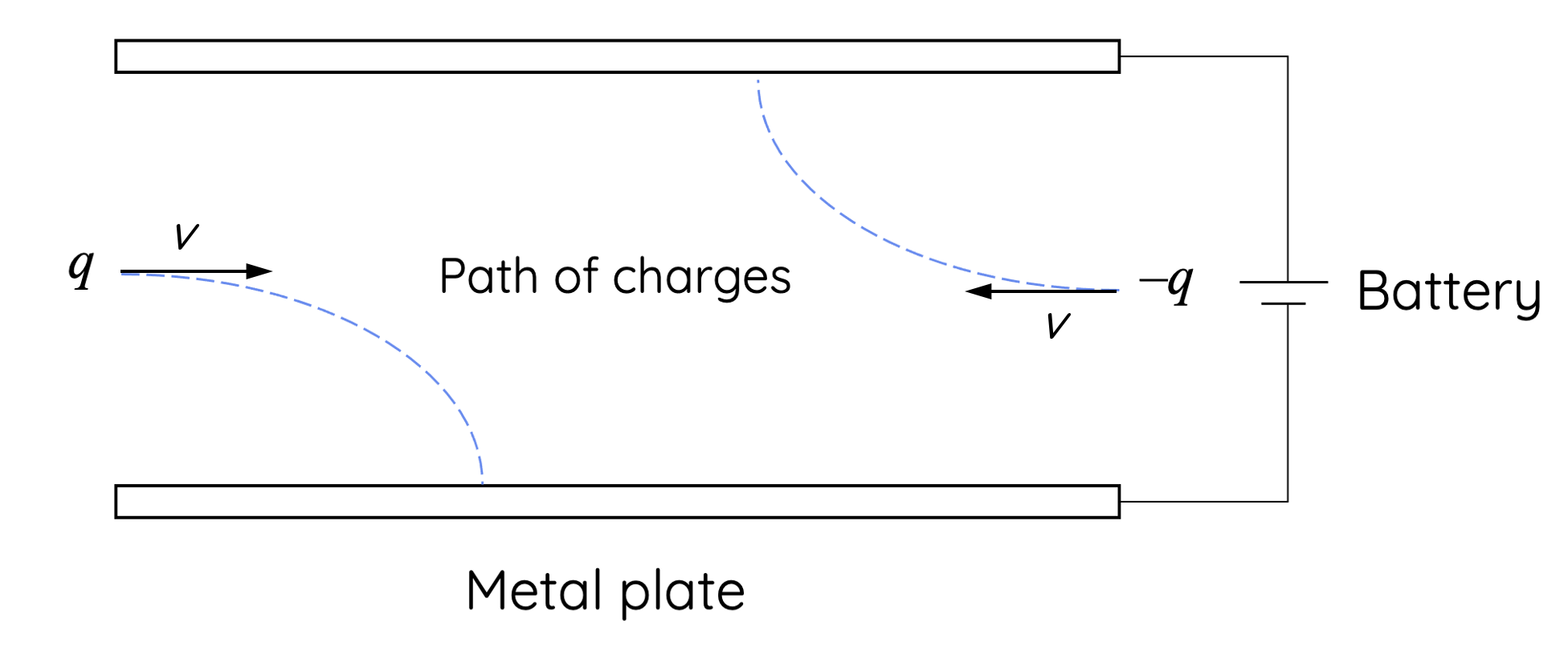Charged Particle in an Electric Field
HSC Physics Syllabus
- investigate and quantitatively derive and analyse the interaction between charged particles and uniform electric fields, including: (ACSPH083)
-
model qualitatively and quantitatively the trajectories of charged particles in electric fields and compare them with the trajectories of projectiles in a gravitational field
Charges in Uniform Electric Fields
This video analyses the interaction between charged particles and uniform electric fields, deriving the relevant syllabus equations. The video also qualitatively and quantitatively compares the trajectory of charged particles in electric fields to that of projectiles in gravitational fields.
Electric Field Strength
Students are advised to revise knowledge from Introduction to Electric Fields.
When two parallel charged plates are connected to a potential difference, they produce a uniform electric field with strength:
`E=V/d`
where,
- E is the electric field strength (V m-1 or N C-1)
- V is the potential difference or voltage (V) between parallel charged plates
- d is the perpendicular distance between parallel charged plates (m).
The direction of the electric field always goes from the positively charged plate to the negatively charged plate, as shown below.

$$E = \frac{10}{5} = 2 \, V m^{-1} \text{ downwards}$$

When a charged particle is placed in a uniform electric field, it experiences an electric force that is proportional to the magnitude of the charge and the strength of the electric field. This force acts in the direction of the electric field if the charge is positive, or opposite to the field if the charge is negative.
`F_E=qE`
where,
- F is the force (N)
- q is the charge of the particle (C)
- E is the electric field strength (V m-1 or N C-1)
The electric field strength can therefore be also expressed in the form:
`E=F/q`
Now, since:
then,
`F/q=V/d`
In a uniform electric field, this force is constant, leading to a uniform acceleration of the charge in the direction of the force according to Newton's second law (`F = ma`).

If a charge moves in an electric field with velocity (`v_{_|_}`) that is perpendicular to the electric field lines, it undergoes parabolic motion. This is because the uniform acceleration due to the field only affects the charge's velocity component (`v_{||}`) that is parallel to the field; the velocity component that is perpendicular to the electric field remains constant (unaffected).
This means `v_{||}` will increase due to the electric force while `v_{_|_}` remains constant during the charge's motion in an electric field.
Electric Fields vs Gravitational Fields
This parabolic trajectory is similar to that of a mass in gravitational fields. The vertical component of velocity which is parallel to the direction of gravity is affected, whereas the horizontal component of velocity (perpendicular to gravity) remains constant (unaffected).
|
Feature |
Motion in Electric Field |
Motion in Gravitational Field |
|
Shape of trajectory |
Parabolic (for uniform electric fields) |
Parabolic |
|
Is constant force experienced by projectile? |
Yes, in uniform electric fields. |
Yes, in uniform gravitational fields. |
|
Can be analysed by vector resolution into horizontal and vertical components? |
Yes |
Yes |
|
Horizontal component of motion |
Constant |
Constant |
|
What undergoes motion? |
Charged particles |
Any type of matter |
|
Magnitude of acceleration |
Typically much larger due to projectiles being of very small mass |
Typically much smaller, due to projectiles being of larger mass. |
|
Magnitude of forces |
Depends on different parameters than gravitational force.
F = qE (force per unit charge)
|
Depends on different parameters than electric force
F = mg (force per unit mass)
|
|
Direction of force |
Depends on nature of charge of projectile:
|
Always attractive towards centre of mass of source of gravitational attraction. |
Why is Gravity not Considered for Motion of Charged Particles?
Charged particles experience negligible amounts of gravitational force. For example, an electron on the surface of Earth has gravitational force of magnitude:
Calculation Example
A proton enters an electric field produced by a pair of parallel metal plates with potential difference of 150 V and separated by a distance of 2.0 m apart.
Calculate the force and acceleration due to the electric field for the proton.
Next section: Work Done in Electric Fields